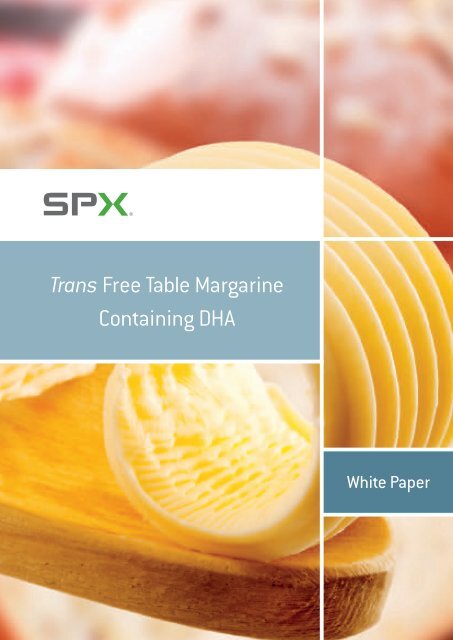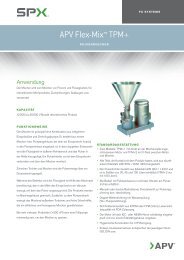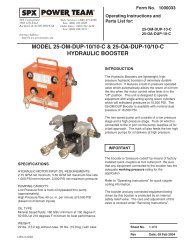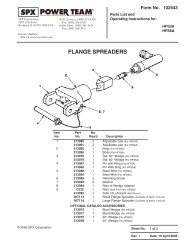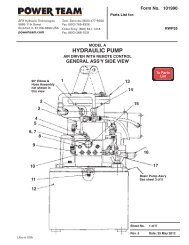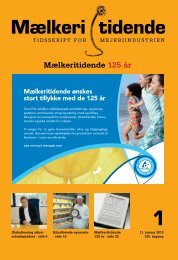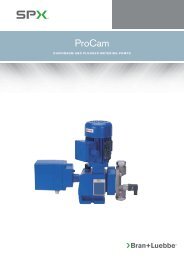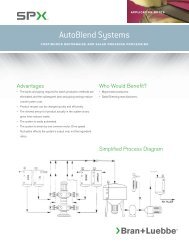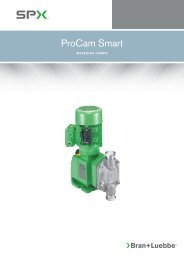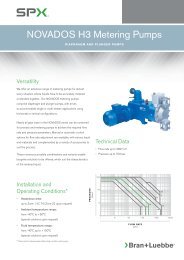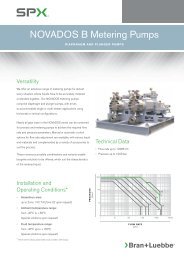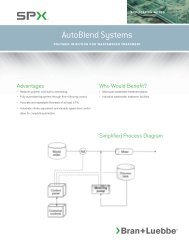Trans free table margarine_07_12_GB - SPX
Trans free table margarine_07_12_GB - SPX
Trans free table margarine_07_12_GB - SPX
You also want an ePaper? Increase the reach of your titles
YUMPU automatically turns print PDFs into web optimized ePapers that Google loves.
<strong>Trans</strong> Free Table Margarine<br />
Containing DHA<br />
White Paper
<strong>Trans</strong> Free Table Margarine Containing DHA<br />
Table of Contents<br />
Executive summary 3<br />
Introduction to <strong>SPX</strong> Flow Technology 3<br />
Vision and commitment 3<br />
Customer focus 3<br />
Introduction to trans <strong>free</strong> <strong>table</strong> <strong>margarine</strong> 4<br />
Experimental work 4<br />
Conclusion 7<br />
2<br />
<strong>07</strong>/<strong>12</strong>_<strong>GB</strong>
<strong>Trans</strong> Free Table Margarine Containing DHA<br />
EXECUTIVE SUMMARY<br />
INTRODUCTION TO<br />
<strong>SPX</strong> FLOW TECHNOLOGY<br />
Food companies today are like other manufacturing<br />
businesses not only focusing on the reliability and quality of<br />
the food processing equipment but also on various services<br />
which the supplier of the processing equipment can deliver.<br />
Apart from the efficient processing lines we deliver, we can<br />
be a partner from the initial idea or project stage to the final<br />
commissioning phase, not to forget the important<br />
after-market service. <strong>SPX</strong> Flow Technology has Gerstenberg<br />
Schröder installations in more than 110 countries around the<br />
world.<br />
VISION AND COMMITMENT<br />
<strong>SPX</strong>'s Flow Technology segment designs, manufactures<br />
and markets process engineering and automation solutions<br />
to the dairy, food, beverage, marine, pharmaceutical and<br />
personal care industries through its global operations.<br />
We are committed to helping our customers all over the<br />
world to improve the performance and profitability of<br />
their manufacturing plant and processes. We achieve this<br />
by offering a wide range of products and solutions from<br />
engineered components to design of complete process<br />
plants supported by world-leading applications and<br />
development expertise.<br />
We continue to help our customers optimize the<br />
performance and profitability of their plant throughout its<br />
service life with support services tailored to their individual<br />
needs through a coordinated customer service and spare<br />
parts network.<br />
CUSTOMER FOCUS<br />
<strong>SPX</strong> Flow Technology develops, manufactures and installs<br />
modern, high efficient and reliable processing lines for<br />
the food industry. For the production of crystallized fat<br />
products like <strong>margarine</strong>, butter, spreads and shortenings<br />
<strong>SPX</strong> offers Gerstenberg Schröder solutions which also<br />
comprise process lines for emulsified food products such as<br />
mayonnaise, sauces and dressings.<br />
<strong>07</strong>/<strong>12</strong>_<strong>GB</strong><br />
3
<strong>Trans</strong> Free Table Margarine Containing DHA<br />
INTRODUCTION TO TRANS FREE TABLE<br />
MARGARINE<br />
It is generally accepted that fats and oils play a major role in<br />
human nutrition as an important dietary source of energy and<br />
supply the body with essential fatty acids. Even though the<br />
Western diet is relatively rich in fat, the majority of the population<br />
does not consume adequate levels of the important ω-3 long<br />
chain PUFA, naturally present in marine foods among others.<br />
DHA belong to the group of the important ω-3 long chain PUFA<br />
and research concerning this class of compounds have been<br />
going on since 1929 (Burr and Burr). The majority of the studies<br />
reported in the literature suggest that the decline in DHA intake<br />
could have serious implications for public health. Several clinical<br />
studies have shown that DHA supplementation resulted in<br />
lowering of serum triglyceride levels and improving the HDL:LDL<br />
cholesterol ratio. These findings suggest that supplementing<br />
with DHA might be cardioprotective. Other studies indicate that<br />
certain plasma DHA levels are important in regard to infant<br />
development. Prevention and treatment of other diseases<br />
by supplementation of DHA has been and still are under<br />
investigation such as: cancer, inflammatory diseases, psoriasis<br />
and age related diseases. This list is only intended as examples<br />
of studies reported in the literature and should not be considered<br />
as all inclusive.<br />
By fortification of common foods the intake of certain basic<br />
nutrients such as DHA could be increased and people could<br />
then live healthier without changing their dietary habits. This is<br />
the basic for the growing interest for functional foods. Functional<br />
food can be defined as foods containing ingredients that provide<br />
health benefits or even disease prevention.<br />
It is no news that health <strong>margarine</strong> such as poly-unsaturated<br />
<strong>margarine</strong> can be produced since these products have been<br />
on the market for decades. These products contain a declared<br />
minimum level of polyunsaturated and essential fatty acids,<br />
and normally low amounts of salt. Additionally, spreadable fat<br />
products containing fish oils and thus high in particularly ω-3<br />
long chain fatty acids have been on the market for years in<br />
Europe, manufactured under the names 'Pact', 'Omega' and 'Blue<br />
Gaio'.<br />
EXPERIMENTAL WORK<br />
In general, like production of ordinary <strong>margarine</strong> the production<br />
The source of DHA in the defined <strong>margarine</strong> does not originate<br />
from fish oil like the above listed products, but from a marine<br />
microalgae strain that produce vege<strong>table</strong> oil containing large<br />
amounts of DHA, i.e. 40% DHA content of the vege<strong>table</strong> oil.<br />
The defined fat blend used in this study consisted additionally of<br />
interesterified fat in order to minimise the trans fatty acid content<br />
in the <strong>margarine</strong>. Various degrees of cooling along with different<br />
degrees of mechanical sheer, i.e. RPM of pin rotor machine<br />
were applied. In addition, it was examined if the <strong>margarine</strong> could<br />
achieve a 6 months shelf life, based on analytical results and<br />
organoleptic evaluation.<br />
The interest in producing <strong>margarine</strong> and spreads based on<br />
interesterified fat blends have arose from the increasing<br />
awareness of the influence of trans fatty acids on health.<br />
Traditionally, <strong>margarine</strong> contains partially hydrogenated vege<strong>table</strong><br />
oil since hydrogenated fats crystallize relatively faster than<br />
unhydrogenated fats and provide the finished <strong>margarine</strong> with<br />
the necessary consistency. But during the hydrogenation<br />
process various trans fatty acids are formed and at present<br />
these isomers are thought to be nutritionally undesirable. Several<br />
studies reported in the last decade seem to indicate a correlation<br />
between a certain intake of these isomers and the risk of<br />
cardiovascular heart disease.<br />
On this basis, there seems to be a global trend towards a<br />
reduction of the trans fatty acid content in <strong>margarine</strong> and other<br />
foods especially after Denmark by law has banned trans fatty<br />
acid and US FDA recommends reducing the contents to less<br />
than 1% of the energy. Consequently, the Food Industry will<br />
be forced to decrease the use of partially hydrogenated fat<br />
substantially, leading to a need of a replacement that provides<br />
among other things the <strong>margarine</strong> and spreads with the required<br />
functionalities and characteristics.<br />
4<br />
<strong>07</strong>/<strong>12</strong>_<strong>GB</strong>
<strong>Trans</strong> Free Table Margarine Containing DHA<br />
Table 1 shows the composition of the fat blend used for the<br />
production of the soft <strong>table</strong> <strong>margarine</strong> containing DHA. The hard<br />
stock of the defined fat blend consisted mainly of interesterified<br />
oil in order to minimise the trans fatty acid content in the<br />
product. The interesterified fat blend, Body fat 62, was supplied<br />
by AarhusKarlshamn, Denmark, and chosen since Body fat<br />
62 is applicable for various <strong>margarine</strong>s and spreads. Martek<br />
Biosciences Inc., USA provided vege<strong>table</strong> oil from microalgae<br />
containing 40% DHA. The antioxidants, ascorbyl palmitate and<br />
tocopherols are added to the oil by the manufacturer.<br />
INGREDIENTS DHA-BLEND (%) TYPICAL (%)<br />
Body fat 62 37 -<br />
Hydrogenated<br />
vege<strong>table</strong> oil 41°/42°C<br />
Hydrogenated<br />
vege<strong>table</strong> oil 35°/36°C<br />
- 20<br />
- 20<br />
Liquid oil 62 60<br />
DHA 1 -<br />
Table 1: Composition of the fat blend<br />
The emulsifier and flavour were supplied by Danisco A/S,<br />
Denmark. Apart from lecithin being an emulsifier, lecithin and<br />
ascorbyl palmitate were additionally added as antioxidants to<br />
the <strong>margarine</strong> fat blend in order to achieve extended oxidative<br />
stability. Studies have shown that binary systems of ascorbyl<br />
palmitate and lecithin are strongly synergistic in delaying<br />
peroxidation. However, the studies also showed that ternary<br />
blends of tocopherol (2%), ascorbyl-palmitate (0.1%) and lecithin<br />
(0.5%) provide the greatest protection against autooxidation.<br />
A typical soft <strong>table</strong> <strong>margarine</strong> fat blend is additionally listed for<br />
comparison. It can be noted that this blend contains partially<br />
hydrogenated soybean oil, thus exhibits a content of trans fatty<br />
acids of approximately 15-20% depending on the hydrogenation<br />
process.<br />
TEMPERATURE DHA-BLEND (%) TYPICAL (%)<br />
10°C 27 28<br />
20°C 14 14<br />
30°C 5 3<br />
40°C - -<br />
Table 2: Solid fat content (SFC) values<br />
Low trans and zero trans <strong>margarine</strong> can be prepared from<br />
interesterified fat blends. Going through some of the studies<br />
reported in the literature, it is evident that interesterified fat<br />
blends show different crystallization behavior than hydrogenated<br />
fat blends. Therefore, attention should be paid to the composition<br />
and to the processing parameters when interesterified fat blends<br />
are involved in <strong>margarine</strong> and spreads production. However,<br />
quality <strong>margarine</strong> and spreads can be achieved exhibiting<br />
excellent sensoric properties.<br />
The soft <strong>table</strong> <strong>margarine</strong> was produced based on the following<br />
set-up:<br />
HPP → first chiller with intermediate crystalliser → second chiller<br />
→ third chiller → pin rotor machine (volume 2 liters) → filling<br />
machine. The emulsion is transferred thought the HHP with a<br />
capacity of 90 kg/hour to the first cooling section of the SSHE,<br />
the GS Perfector. Here sub cooling of the emulsion, nucleation<br />
and subsequently crystal growth takes place. Before entering the<br />
second cooling section the semi crystallized emulsion is kneaded<br />
in the intermediate crystalliser mounted directly on the shaft on<br />
the first cooling tube. Intermediate crystalliser is employed in<br />
order to yield mechanical work to the product and hereby ensure<br />
homogeneity, plasticity and spreadability. After the second and<br />
the third cooling tube the crystallized fat is finally kneaded in the<br />
GS pin rotor machine before filling.<br />
Prior to <strong>margarine</strong> production, information on the characteristics<br />
of the fat blend was obtained. The Solid Fat Content (SFC)<br />
profile was determined and the values shown correspond to SFC<br />
values normally obtained for a typical soft <strong>table</strong> <strong>margarine</strong>.<br />
GS pin rotor machine<br />
<strong>07</strong>/<strong>12</strong>_<strong>GB</strong><br />
5
<strong>Trans</strong> Free Table Margarine Containing DHA<br />
Where the rotation, i.e. the RPM of the pin in the intermediate<br />
crystalliser depends on the rotation of the rotor shaft in the<br />
chilling tube, the GS pin rotor machine is an independent<br />
machine with variable speed of the pin rotor. In these trials low,<br />
medium and high RPM were applied. The following <strong>table</strong> 3<br />
shows the processing conditions.<br />
SAMPLE<br />
1 ST<br />
CHILLER<br />
2 ND<br />
CHILLER<br />
3 RD<br />
CHILLER<br />
PIN ROTOR<br />
RPM<br />
1 -5°C -5°C -5°C 50<br />
2 -5°C -5°C -5°C 250<br />
3 -5°C -5°C -5°C 500<br />
4 -15°C -5°C -5°C 500<br />
5 -15°C -5°C -5°C 250<br />
6 -15°C -5°C -5°C 50<br />
Table 3: Processing conditions<br />
The trials can be grouped into two groups, sample 1-3 where the<br />
amount of cooling were for all 3 chilling tubes -5°C, and sample<br />
4-6 where the amount of cooling in the first chilling tube was<br />
changed to -15°C. The cooling is applied by means of ammonia.<br />
In addition, the different RPM of the pin rotor machine were then<br />
applied for each cooling parameters.<br />
The crystallization process was followed during the processing of<br />
<strong>margarine</strong> by taking samples after each chilling tube and working<br />
unit for instant SFC determination at 20°C. This graph illustrates<br />
the differences in the instant SFC measured at various places<br />
in the processing of soft <strong>table</strong> <strong>margarine</strong>. The measurement<br />
SFC1 corresponds to the solid fat content after the first chilling<br />
tube, SFC2 correspond to the solid fat content after the second<br />
chilling tube, and so forth. The sample numbers correspond to<br />
the various processing parameters.<br />
The instant SFC profile of the all the samples show a steady<br />
increase in the SFC values measured after each cooling tube<br />
during processing. However, it can be noted sample 4-6 initially<br />
show a significantly higher content of solids at SFC1 and SFC2<br />
when compared to sample 1-3, which not surprisingly means that<br />
intensive cooling onset the crystallization process.<br />
A stagnation or decrease in instant SFC value measured after<br />
the pin rotor machine may be expected. Since the pin worker<br />
functions as a kneading unit, the addition of mechanical work<br />
without cooling creates a stagnation for sample 2 and 6, and a<br />
decrease in the crystallization for the rest of the samples. These<br />
results might indicate that optimal cooling temperature and RPM<br />
of the pin worker machine for the defined blend and processing<br />
parameters correspond to the parameters of sample 6. Sample<br />
6 shows the highest value in SFC by the end of processing<br />
and additionally no decrease in SFC over the pin worker. The<br />
stagnation or even increase over the pin worker means that<br />
the solids created prior in the process is not melted due to too<br />
intense mechanical treatment.<br />
Water droplet size and distribution was analyzed by Nuclear<br />
Magnetic Resonance, NMR, using Minispec from Bruker,<br />
Germany. The most important parameter in characterizing<br />
any emulsion is the size distribution. Two emulsions may have<br />
the same average droplet size and yet exhibit quite dissimilar<br />
behavior because of differences in their distribution of diameters.<br />
Stability of the emulsion is one of the phenomena influenced by<br />
both relative size and size distribution. Size is an individual droplet<br />
property, but any property of one droplet is not an interesting<br />
value in the overall emulsion evaluation. The real interest is the<br />
entire size distribution of the emulsion.<br />
17<br />
16<br />
15<br />
14<br />
13<br />
<strong>12</strong><br />
11<br />
10<br />
9<br />
8<br />
7<br />
6<br />
5<br />
SFC 1 SFC 2 SFC 3 SFC 4<br />
Sample 1:<br />
Sample 2:<br />
Sample 3:<br />
Sample 4:<br />
Sample 5:<br />
Sample 6:<br />
1 2 3 4 5 6<br />
2.5% < 0.9 0.9 1.0 1.2 1.2 1.3<br />
50.0% < 2.9 3.0 2.9 2.8 2.8 2.8<br />
97.5% < 9.6 9.6 9.1 6.8 6.4 5.7<br />
Table 4: Water droplet size distribution<br />
Figure 1: Instant SFC meassured during the <strong>margarine</strong> processing<br />
It was examined if an optimal cooling temperature and/or RPM<br />
of the pin rotor machine could be determined by evaluating the<br />
various instant SFC profiles corresponding to the degrees of<br />
cooling and RPM of the GS pin rotor machine.<br />
For all the samples it can be noted that less than 2.5% of the<br />
water droplets have a size of approximately 1 micron. No major<br />
differences were found for the mean value size distribution, since<br />
50% of the droplets have a size of approximately 3 microns.<br />
However, the values for the remaining 2.5% of the water droplets<br />
show variation. The water droplets appear to be larger, i.e. 9.5<br />
6<br />
<strong>07</strong>/<strong>12</strong>_<strong>GB</strong>
<strong>Trans</strong> Free Table Margarine Containing DHA<br />
microns, for the samples produced with less intensive chilling<br />
when compared to sizes of around 6.4 microns for samples<br />
produced with more intensive chilling in the first cooling section<br />
of the GS Perfector.<br />
Examples of SSHE units for fat crystallization from the GS brand:<br />
GS Nexus and GS Perfector<br />
Typical water droplet distribution values for <strong>margarine</strong> are found<br />
in to be in the range described above. However, in regard to low<br />
fat spreads the distribution might be much wider depending on<br />
the composition of the product. In addition, the results of the<br />
water droplet determination indicate that the RPM of the pin<br />
rotor machine does not significantly affect the water droplet size<br />
in soft <strong>table</strong> <strong>margarine</strong>.<br />
expected that greater differences were found. However, one has<br />
to remember that these results are indications, but due to the<br />
sample size no statistically significance can be determined.<br />
CONCLUSION<br />
It can be concluded that good quality soft <strong>table</strong> <strong>margarine</strong><br />
containing DHA can be produced. The results obtained by<br />
droplet size determination suggest that the distribution is<br />
affected by the intensity of cooling and not by the RPM of the<br />
pin rotor. In order to establish statistically significant correlation<br />
between the objective water droplet size distribution method, and<br />
the subjective evaluation, further work needs to be done.<br />
Work is still being done in order to clarify the differences in<br />
the crystallization process when <strong>margarine</strong> is composed of<br />
interesterified fats. By optimizing not only the composition of the<br />
interesterified fat blends, but also the processing parameters<br />
on the basis of analytical and processing results, a better<br />
understanding of the crystallization process when interesterified<br />
fat blends are involved might be apparent..<br />
Peroxide values of the produced <strong>margarine</strong> were measured by<br />
Martek Biosciences Corp. Using standardised AOCS methods<br />
(Cd8-53). In general, peroxide values of less than 5 will be<br />
accepted.<br />
1 2 3 4 5 6<br />
3 months 1.19 1.16 1.17 1.30 1.26 1.25<br />
6 months 2.57 2.20 2.29 2.17 2.23 2.03<br />
Table 5: Peroxide values<br />
It can be noted that none of the listed values are higher than<br />
2.5, even after 6 months. No significant difference between<br />
the values for 3 and 6 months individually was found. However,<br />
significance was found between the values for 3 and 6 months<br />
(P< 0.05, two sample t-test, one sided). Since the peroxide value<br />
test alone is not a satisfactory measure of oxidation state due to<br />
potential side reactions, organoleptic evaluations were done. No<br />
overall differences in taste between the samples were found.<br />
When comparing the subjective evaluation for this defined study,<br />
i.e. the organoleptic evaluation, and the objective measurements<br />
such as water droplet distribution and peroxide values, it was<br />
<strong>07</strong>/<strong>12</strong>_<strong>GB</strong><br />
7
ABOUT <strong>SPX</strong><br />
Based in Charlotte, North Carolina, <strong>SPX</strong> Corporation (NYSE: SPW) is a global Fortune 500 multi-industry manufacturing leader<br />
For more information, please visit www.spx.com.<br />
<strong>SPX</strong> FLOW TECHNOLOGY COPENHAGEN A/S<br />
Oestmarken 7<br />
DK-2860 Soeborg<br />
Denmark<br />
P: +45 7027 8222<br />
gs.dk.sales@spx.com<br />
<strong>SPX</strong> FLOW TECHNOLOGY HANSE GMBH<br />
Bernsteindreherweg 7<br />
D-23556 Lübeck<br />
Germany<br />
P: +49 451 3709 0<br />
gs.de.sales@spx.com<br />
<strong>SPX</strong> reserves the right to incorporate our latest design and material changes without notice or obligation.<br />
Design features, materials of construction and dimensional data, as described in this bulletin, are provided for your information only and should not be relied upon unless<br />
confirmed in writing. Please contact your local sales representative for product availability in your region. For more information visit www.spx.com.<br />
The green “>” is a trademark of <strong>SPX</strong> Corporation, Inc..<br />
ISSUED <strong>07</strong>/20<strong>12</strong> <strong>GB</strong><br />
COPYRIGHT © 20<strong>12</strong> <strong>SPX</strong> Corporation


